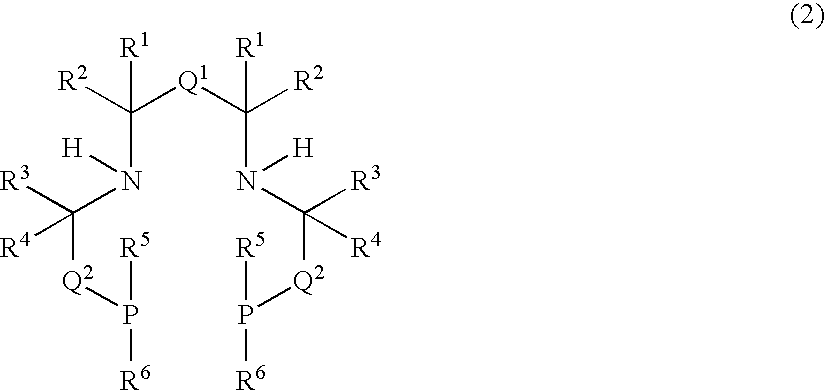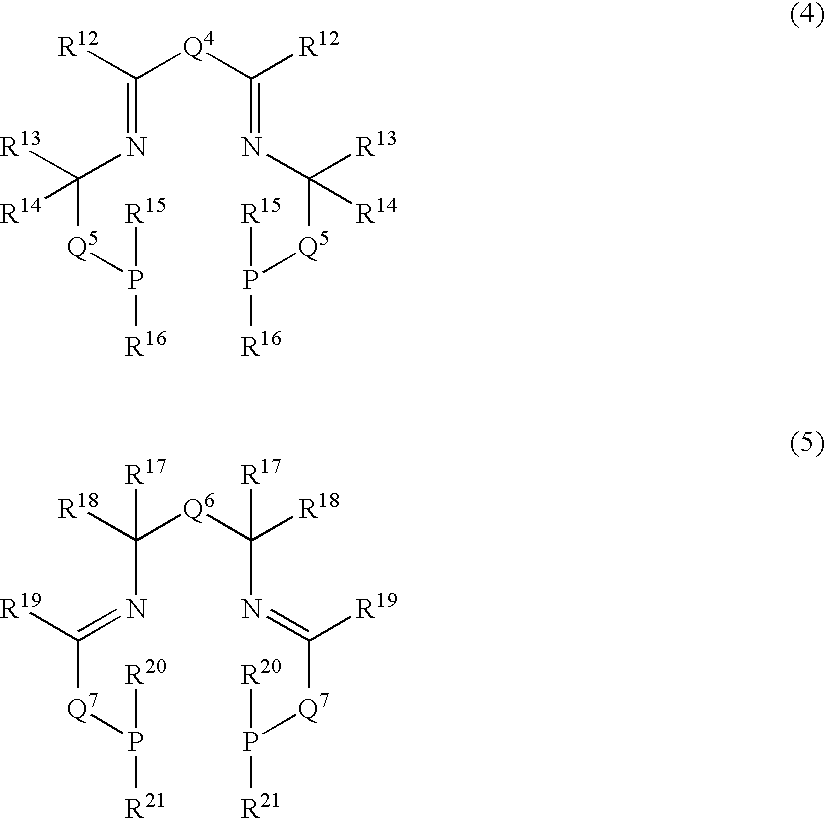Alcohol production method by reducing ester or lactone with hydrogen
a technology of ester or lactone and alcohol, which is applied in the direction of organic reduction, physical/chemical process catalyst, organic compound/hydride/coordination complex catalyst, etc., can solve the problems of large amount of very expensive catalysts, large waste generated by reducing agents, and high catalyst cost. , the effect of high yield
- Summary
- Abstract
- Description
- Claims
- Application Information
AI Technical Summary
Benefits of technology
Problems solved by technology
Method used
Image
Examples
example 1
Synthesis of Ruthenium Complex 1 and Ester Reduction Using the Same
[0139]
[0140][RuClH(PPh3)3] (1.73 mmol) and L1a (1.73 mmol) were charged into a 100 mL-flask, and air inside the flask was replaced with nitrogen. Then, tetrahydrofuran (25 mL) was added to dissolve [RuClH(PPh3)3] and L1a. After 1 hour of heating under reflux, most of the tetrahydrofuran was collected under reduced pressure. Thereafter, hexane (25 mL) was added, and a crystal was filtered and washed with hexane, tetrahydrofuran, and diethylether. The resultant crystal was dried under reduced pressure, and a ruthenium complex 2 (743 mg) was obtained.
[0141]1H NMR (300 MHz, C6D6):
[0142]δ=−15.92 (t, J=27.2 Hz, 1H), 3.31 (m, 2H), 3.96 (m, 2H), 6.88-8.20 (m, 30H)
[0143]31P NMR (121.5 MHz, C6D6)
[0144]δ=59.9 (d, J=22 Hz)
[0145]Under a stream of nitrogen, the ruthenium complex 2 (0.2 mmol) was suspended in toluene (20 mL). A solution of sodium borohydride (5.4 mmol) in ethanol (20 mL) was added, and the mixture was heated for 1 ...
example 2
Hydrogenation of Methyl Benzoate
[0155]
[0156]Methyl benzoate (7.99 mmol), a ruthenium complex 1 (0.004 mmol), and tetrahydrofuran (6 mL) were charged into a 100-mL autoclave equipped with a stirrer. Then, the mixture was subjected to hydrogenation at a hydrogen pressure of 5 MPa at 80° C. for 15.5 hours. The reaction liquid was analyzed by gas chromatography. As a result, benzyl alcohol was synthesized at a conversion rate of 96.2% and a selectivity of 86.7%.
example 3
Hydrogenation of L-Boc-alanine Methyl Ester
[0157]
[0158]L-Boc-alanine methyl ester (2.46 mmol), a ruthenium complex 1 (0.005 mmol), and tetrahydrofuran (1 mL) were charged into a 100-mL autoclave equipped with a stirrer. Then, the mixture was subjected to hydrogenation at a hydrogen pressure of 5 MPa at 80° C. for 15.5 hours. The reaction liquid was analyzed by gas chromatography. As a result, 2-Boc-aminopropanol was synthesized at a conversion rate of 38.0% and a selectivity of 95.3%. The obtained alcohol had an optical purity of 98.8% ee.
PUM
| Property | Measurement | Unit |
|---|---|---|
| optical purity | aaaaa | aaaaa |
| temperature | aaaaa | aaaaa |
| temperature | aaaaa | aaaaa |
Abstract
Description
Claims
Application Information
 Login to View More
Login to View More - R&D
- Intellectual Property
- Life Sciences
- Materials
- Tech Scout
- Unparalleled Data Quality
- Higher Quality Content
- 60% Fewer Hallucinations
Browse by: Latest US Patents, China's latest patents, Technical Efficacy Thesaurus, Application Domain, Technology Topic, Popular Technical Reports.
© 2025 PatSnap. All rights reserved.Legal|Privacy policy|Modern Slavery Act Transparency Statement|Sitemap|About US| Contact US: help@patsnap.com



